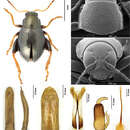Description
provided by Zookeys
MBL = 1.80–2.54 mm; MBH = 1.66–2.40 mm; FBL = 2.11–2.64 mm; FBH = 1.80–2.45 mm; AL/BL = 0.70; MBW = 0.89–1.04; EL/EW = 1.29–1.29; PW/PL= 1.32; EL/PL = 1.87; EWB/PWB = 1.14; EWM/PWM = 1.45–1.45.
Color of elytra usually differs from color of pronotum. Elytra often brown to black, sometimes bronzish. Pronotum bronzish. Head dorsally dark bronzish. Antennomere 1 yellow but darker than antennomeres 2–5. Antennomeres 2–5 yellow. Antennomeres 6–7 partly brown. Antennomeres 8–11 brown with yellow at base. Tibiae yellow, tasomeres yellow with claw segment brown at apex. Pro- and mesofemora light brown with yellow apex. Metafemora brown.
Head hypognathous. Frontal ridge between antennal sockets narrow and convex. Frontolateral sulcus present. Suprafrontal sulcus shallow and faint or deep laterally, shallow in middle. Suprafrontal sulcus slightly concave. Orbital sulcus (above antennal socket) deep. Width of frontal ridge to width of antennal socket: 0.84–0.88. Width of orbital sulcus (above antennal socket) to width of frontolateral sulcus: 0.93–1.16. Surface of vertex sparsely and unevenly covered with 5–6 punctures close to each eye. Numbers of punctures on orbit on each side: 3–5. Numbers of setae along frontolateral sulcus on each side: 8–10. Numbers of setae on frons (triangular area surrounded by frontolateral sulcus and clypeus): 0. Numbers of setae on clypeus: 7. Numbers of setae on labrum: 6. Anterior margin of labrum slightly concave in middle.
Base of pronotum with two short longitudinal impressions without punctures visible only near basal margin. Deep row of large punctures at base of pronotum present on sides, lacking in middle. Pronotal base evenly convex. Lateral sides of pronotum thickened, only slightly convex with maximum width near base. Pronotum quite convex from lateral view. Anterolateral prothoracic callosity protruding antero-laterally, forms strong obtuse angle. Posterolateral prothoracic callosity projects beyond lateral margin of pronotum. Setae on each callosity long, exceeding half of pronotal length. Wrinkles between punctures on pronotum well developed. Diameter of pronotal punctures subequal to distance between them.
Elytra with convex sides. Scutellar row of punctures regular and single. All other rows of punctures regular. Elytral humeral calli well developed. Interspaces between rows of punctures on elytra smooth and glabrous. Numbers of minute punctures lines on each interspace: 2.
First male protarsomere only slightly larger than second. First male protarsomere, length to width ratio: 1.95–2.03. First and second male protarsomeres, length to length ratio: 1.43–1.52, width to width ratio: 0.89–0.91. First male protarsomere, width at apex to width at base: 1.45–1.55. Length of metatibia to distance between denticle and metatibial apex: 2.73–2.95. Large lateral denticle on metatibia sharp. Metatibial serration proximal to large lateral denticle present, obtuse. Metatibia proximad to denticle in dorsal view concave. First male metatarsomere, length to width ratio: 2.78–2.85. First and second male metatarsomeres, length to length ratio: 1.80–1.90, width to width ratio: 0.92–0.96. Third and fourth male metatarsomeres, length to length ratio: 0.62–0.71. Metatibia length to metafemora length about: 0.89. Length of hind leg to length of body about: 1.04.
Apical third of median lobe of aedeagus parallel-sided. Apical part of median lobe in ventral view narrowing abruptly. Ventral longitudinal groove of median lobe poorly developed in apical and basal part, narrow or absent in middle part. Apical part of longitudinal groove as wide as basal. Apical denticle of aedeagus in ventral view poorly differentiated. Apical denticle of aedeagus in lateral view strongly curved ventrally. Minute transverse wrinkles absent on ventral side of median lobe. Median lobe in lateral view slightly sinusoidal near apex. Maximal curvature of median lobe in lateral view situated medially. Width (in middle) to length of median lobe (in ventral view) about: 0.18. Median lobe narrow in lateral view.
Spermathecal receptacle pear-shaped, slightly narrow in middle. Spermathecal pump much shorter than receptacle. Apex of spermathecal pump cylindrical. Spermathecal pump attached to middle of receptacle top. Maximum width of receptacle situated basally. Basal part of receptacle wider than apical. Posterior sclerotization of tignum spoon-shaped, wider than mid section. Mid section of tignum nearly straight. Anterior sclerotization of tignum wider than mid section. Apex of vaginal palpus subdeltoid, with lateral side slightly arching. Sides of mid part of vaginal palpus (before apex) narrowing from base, slightly widening towards apex. Anterior sclerotization of vaginal palpus slightly narrowing anteriorly. Anterior sclerotization of vaginal palpus slightly and evenly curved along length. Anterior end of anterior sclerotization broadly rounded. Length of posterior sclerotization greater than width. Posterior sclerotization about as wide as anterior sclerotization.
- license
- cc-by-3.0
- copyright
- Yongying Ruan, Alexander S. Konstantinov, Siqin Ge, Xingke Yang
- bibliographic citation
- Ruan Y, Konstantinov A, Ge S, Yang X (2014) Revision of the Chaetocnema picipes species-group (Coleoptera, Chrysomelidae, Galerucinae, Alticini) in China, with descriptions of three new species ZooKeys 387: 11–32
- author
- Yongying Ruan
- author
- Alexander S. Konstantinov
- author
- Siqin Ge
- author
- Xingke Yang

